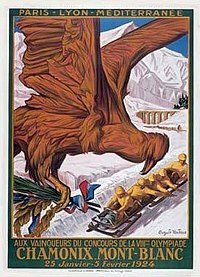[Source]
On January 25, 1924, the first Winter Olympics take off in style at Chamonix in the French Alps. Spectators were thrilled by the ski jump and bobsled as well as 12 other events involving a total of six sports. The “International Winter Sports Week,” as it was known, was a great success, and in 1928 the International Olympic Committee (IOC) officially designated the Winter Games, staged in St. Moritz, Switzerland, as the second Winter Olympics.
Five years after the birth of the modern Olympics in 1896, the first organized international competition involving winter sports was staged in Sweden. Called the Nordic Games, only Scandinavian countries competed. Like the Olympics, it was staged thereon every four years but always in Sweden. In 1908, figure skating made its way into the Summer Olympics in London, though it was not actually held until October, some three months after the other events were over.
In 1911, the IOC proposed the staging of a separate winter competition for the 1912 Stockholm Games, but Sweden, wanting to protect the popularity of the Nordic Games, declined. Germany planned a Winter Olympics to precede the 1916 Berlin Summer Games, but World War I forced the cancellation of both. At the 1920 Olympics in Antwerp, Belgium, ice hockey joined figure skating as an official Olympic event, and Canada took home the first of many hockey gold medals. Soon after, an agreement was reached with Scandinavians to stage the IOC-sanctioned International Winter Sports Week. It was so popular among the 16 participating nations that, in 1925, the IOC formally created the Winter Olympics, retroactively making Chamonix the first.
In Chamonix, Scandinavians dominated the speed rinks and slopes, and Norway won the unofficial team competition with 17 medals. The United States came in third, winning its only gold medal with Charles Jewtraw’s victory in the 500-meter speed-skating event. Canada won another hockey gold, scoring 110 goals and allowing just three goals in five games. Of the nearly 300 athletes, only 13 were women, and they only competed in the figure-skating events. Austrian Helene Engelmann won the pairs competition with Alfred Berger, and Austrian Herma Planck Szabo won the women’s singles. The Olympics offered a particular boost to skiing, a sport that would make enormous strides within the next decade. At Chamonix, Norway won all but one of the nine skiing medals.

[Source]
Hi! I am a robot. I just upvoted you! I found similar content that readers might be interested in:
https://www.history.com/this-day-in-history/first-winter-olympics